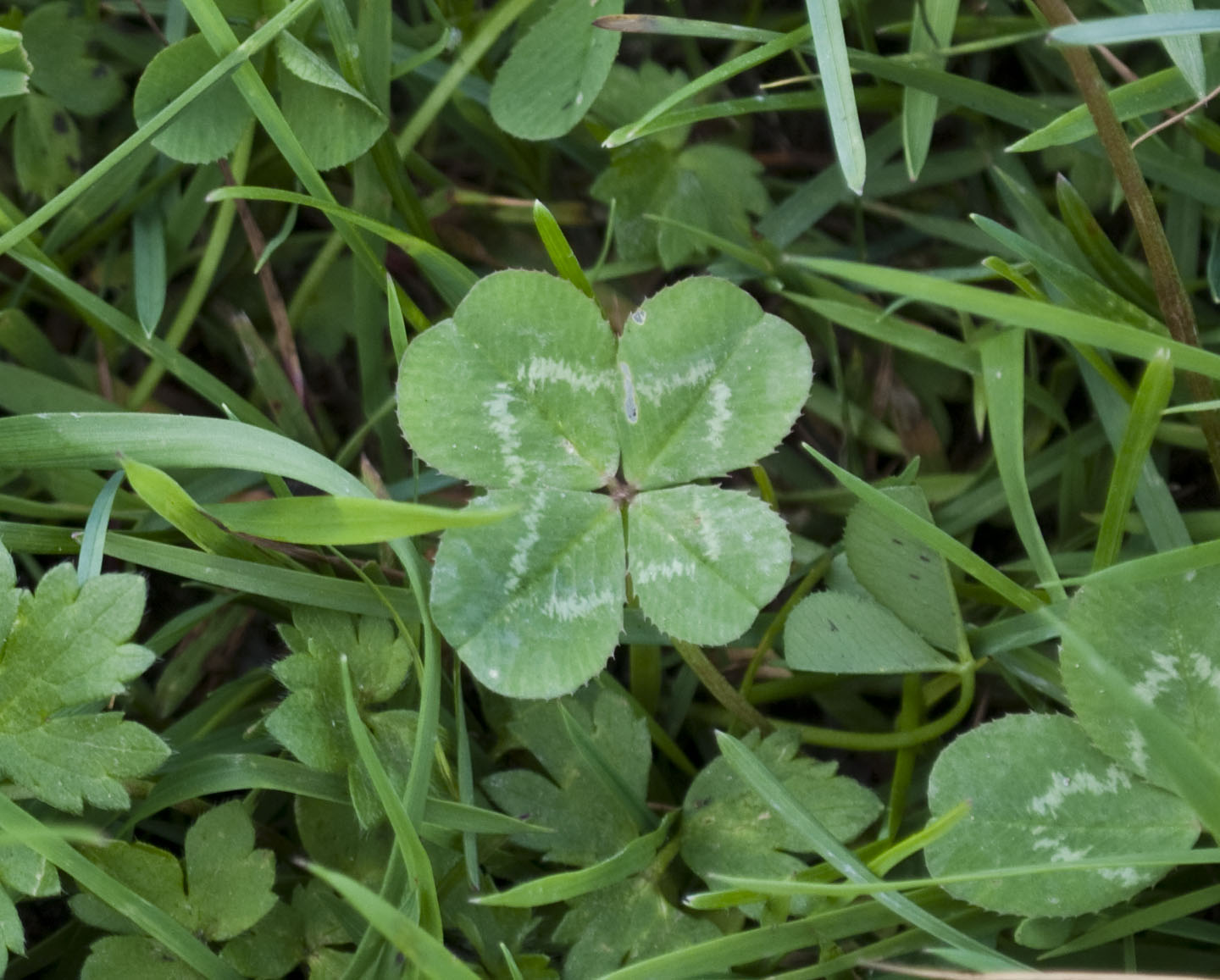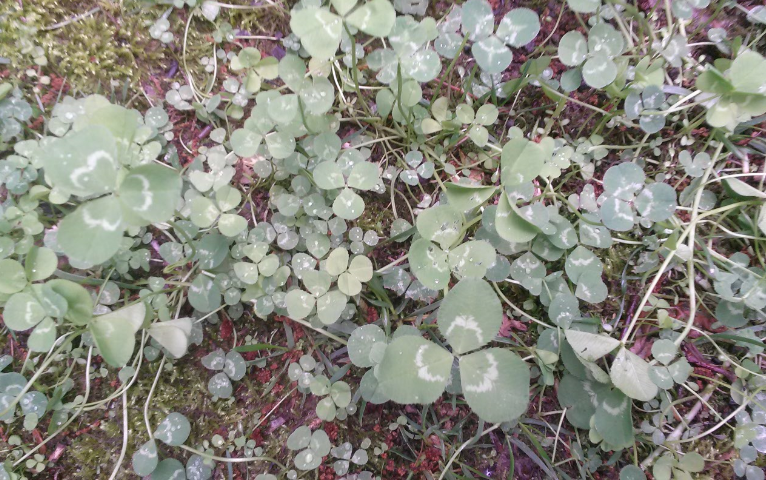|
Clovers
Clovers, also called trefoils, are plants of the genus ''Trifolium'' (), consisting of about 300 species of flowering plants in the legume family Fabaceae originating in Europe. The genus has a cosmopolitan distribution with the highest diversity in the temperate Northern Hemisphere, but many species also occur in South America and Africa, including at high altitudes on mountains in the tropics. They are small annual, biennial, or short-lived perennial herbaceous plants, typically growing up to tall. The leaves are trifoliate (rarely, they have more or fewer than three leaflets; the more (or fewer) leaflets the leaf has, the rarer it is; see four-leaf clover), with stipules adnate to the leaf-stalk, and heads or dense spikes of small red, purple, white, or yellow flowers; the small, few-seeded pods are enclosed in the calyx. Other closely related genera often called clovers include ''Melilotus'' (sweet clover) and ''Medicago'' (alfalfa or Calvary clover). As legumes, clovers ... [...More Info...] [...Related Items...] OR: [Wikipedia] [Google] [Baidu] |
Four-leaf Clover
The four-leaf clover is a rare mutation of the common three-leaf clover that has four Leaflet (botany), leaflets instead of three. According to traditional sayings, such clovers bring good luck, a belief that dates back to at least the 17th century. The term ''four-leaf'' is Botany, botanically a misnomer, as Clover, cloverplants have multiple leaves (multiple clovers), each consisting of a varying number of Leaflet (botany), leaflets, typically three. Occurrence A 2017 survey of approximately 5.7 million clovers in six European countries found the frequency of 4-leaf clovers to be around 5000 to 1 (one 4-leaf clover for every 5076 normal 3-leaf clovers), almost twice the commonly stated probability of 10,000 to 1. According to this survey, the frequency of a 5-leaf clover is 24,390 to 1, and that of a 6-leaf clover is 312,500 to 1. According to Guinness World Records, the clover with the most leaflets ever found had 63 of them, and was discovered by Yoshiharu Watanabe of Nas ... [...More Info...] [...Related Items...] OR: [Wikipedia] [Google] [Baidu] |
Melilotus
''Melilotus'', known as melilot or sweet clover is a genus of legumes in the family Fabaceae, native to Europe, Asia, and Africa. The genus is closely related to ''Trifolium'' (clovers). Several species are common grassland plants and weeds of cultivated ground, and some species are now found worldwide as naturalised plants. The scientific and English names both derive from Greek ''melílōtos'' from ''méli'' (honey), and ''lōtos'' ( lotus), via Latin ''melilōtos'' and Old French ''mélilot''. The alternative name "sweet clover" varies in orthography, also cited as sweet-clover and sweetclover. Other names include "kumoniga", from the Cumans.Bulgarian Folk Customs, Mercia MacDermott, pg 27 Description The species are annual, biennial, or perennial herbaceous plants, growing to 50–150 cm tall, with trifoliate leaves similar to clover but narrower, the leaflets only about half as wide as long, and with a serrated margin; each leaf also has two small basal stipules. The flow ... [...More Info...] [...Related Items...] OR: [Wikipedia] [Google] [Baidu] |
Lupinaster
Clovers, also called trefoils, are plants of the genus ''Trifolium'' (), consisting of about 300 species of flowering plants in the legume family Fabaceae originating in Europe. The genus has a cosmopolitan distribution with the highest diversity in the temperate Northern Hemisphere, but many species also occur in South America and Africa, including at high altitudes on mountains in the tropics. They are small annual, biennial, or short-lived perennial herbaceous plants, typically growing up to tall. The leaves are trifoliate (rarely, they have more or fewer than three leaflets; the more (or fewer) leaflets the leaf has, the rarer it is; see four-leaf clover), with stipules adnate to the leaf-stalk, and heads or dense spikes of small red, purple, white, or yellow flowers; the small, few-seeded pods are enclosed in the calyx. Other closely related genera often called clovers include '' Melilotus'' (sweet clover) and '' Medicago'' (alfalfa or Calvary clover). As legumes, clo ... [...More Info...] [...Related Items...] OR: [Wikipedia] [Google] [Baidu] |
Fabaceae
Fabaceae () or Leguminosae,International Code of Nomenclature for algae, fungi, and plants. Article 18.5 states: "The following names, of long usage, are treated as validly published: ....Leguminosae (nom. alt.: Fabaceae; type: Faba Mill. Vicia L.; ... When the Papilionaceae are regarded as a family distinct from the remainder of the Leguminosae, the name Papilionaceae is conserved against Leguminosae." English pronunciations are as follows: , and . commonly known as the legume, pea, or bean family, is a large and agriculturally important family of |
Africa
Africa is the world's second-largest and second-most populous continent after Asia. At about 30.3 million km2 (11.7 million square miles) including adjacent islands, it covers 20% of Earth's land area and 6% of its total surface area.Sayre, April Pulley (1999), ''Africa'', Twenty-First Century Books. . With nearly billion people as of , it accounts for about of the world's human population. Demographics of Africa, Africa's population is the youngest among all the continents; the median age in 2012 was 19.7, when the worldwide median age was 30.4. Based on 2024 projections, Africa's population will exceed 3.8 billion people by 2100. Africa is the least wealthy inhabited continent per capita and second-least wealthy by total wealth, ahead of Oceania. Scholars have attributed this to different factors including Geography of Africa, geography, Climate of Africa, climate, corruption, Scramble for Africa, colonialism, the Cold War, and neocolonialism. Despite this lo ... [...More Info...] [...Related Items...] OR: [Wikipedia] [Google] [Baidu] |
Flower
Flowers, also known as blooms and blossoms, are the reproductive structures of flowering plants ( angiosperms). Typically, they are structured in four circular levels, called whorls, around the end of a stalk. These whorls include: calyx, modified leaves; corolla, the petals; androecium, the male reproductive unit consisting of stamens and pollen; and gynoecium, the female part, containing style and stigma, which receives the pollen at the tip of the style, and ovary, which contains the ovules. When flowers are arranged in groups, they are known collectively as inflorescences. Floral growth originates at stem tips and is controlled by MADS-box genes. In most plant species flowers are heterosporous, and so can produce sex cells of both sexes. Pollination mediates the transport of pollen to the ovules in the ovaries, to facilitate sexual reproduction. It can occur between different plants, as in cross-pollination, or between flowers on the same plant or even the same f ... [...More Info...] [...Related Items...] OR: [Wikipedia] [Google] [Baidu] |
Adnation
In botany, adnation is the fusion of two or more whorls of a flower, e.g. stamens to petals, within angiosperms (flowering plant Plants are the eukaryotes that form the Kingdom (biology), kingdom Plantae; they are predominantly Photosynthesis, photosynthetic. This means that they obtain their energy from sunlight, using chloroplasts derived from endosymbiosis with c ...s). This is in contrast to connation, the fusion among a single whorl. References Plant anatomy {{botany-stub ... [...More Info...] [...Related Items...] OR: [Wikipedia] [Google] [Baidu] |
Stipule
In botany, a stipule is an outgrowth typically borne on both sides (sometimes on just one side) of the base of a leafstalk (the petiole (botany), petiole). They are primarily found among dicots and rare among monocots. Stipules are considered part of the anatomy of the leaf of a typical flowering plant, although in many species they may be inconspicuous —or sometimes entirely absent, and the leaf is then termed ''exstipulate''. At the other end of the scale are species like ''Artocarpus elasticus'' where the stipules can be up to eight inches (twenty cm) in length. (In some older botanical writing, the term "stipule" was used more generally to refer to any small leaves or leaf-parts, notably prophylls.) The word ''stipule'' was coined by Carl Linnaeus, Linnaeus''Concise English Dictionary'' Wordsworth Editions Ltd. 1994, from Latin ''stipula'', straw, stalk. Types of stipules General characteristics The position of stipules on a plant varies widely from species to species, ... [...More Info...] [...Related Items...] OR: [Wikipedia] [Google] [Baidu] |







